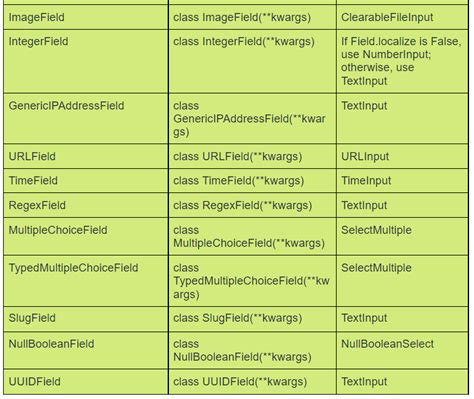Django, a high-level Python web framework, provides an extensive set of tools and libraries to build robust and scalable web applications. One of the key features of Django is its built-in support for forms, which makes it easy to handle user input and validate data. In this article, we will explore five essential Django form fields that you need to know to build robust and efficient forms in your Django applications.

1. CharField: For Single-Line Text Input
CharField is one of the most commonly used form fields in Django. It is used to create a single-line text input field, where users can enter a small amount of text, such as their name, email address, or phone number. CharField is equivalent to the HTML element.
Here is an example of how to use CharField in a Django form:
from django import forms
class ContactForm(forms.Form):
name = forms.CharField(max_length=255)
email = forms.CharField(max_length=255)
In this example, we define a ContactForm with two CharField instances: name and email. The max_length parameter specifies the maximum number of characters that can be entered in each field.
Using CharField with Widgets
Django provides a range of built-in widgets that you can use to customize the appearance and behavior of your form fields. For example, you can use the Textarea widget to create a multi-line text input field:
from django import forms
class ContactForm(forms.Form):
message = forms.CharField(widget=forms.Textarea)
In this example, we define a CharField instance called message, and specify the Textarea widget as its widget.
2. IntegerField: For Integer Input
IntegerField is used to create a form field that accepts integer values. It is equivalent to the HTML element.
Here is an example of how to use IntegerField in a Django form:
from django import forms
class OrderForm(forms.Form):
quantity = forms.IntegerField(min_value=1, max_value=100)
In this example, we define an OrderForm with an IntegerField instance called quantity. The min_value and max_value parameters specify the minimum and maximum values that can be entered in the field.

3. DateField: For Date Input
DateField is used to create a form field that accepts date values. It is equivalent to the HTML element.
Here is an example of how to use DateField in a Django form:
from django import forms
class BookingForm(forms.Form):
arrival_date = forms.DateField()
departure_date = forms.DateField()
In this example, we define a BookingForm with two DateField instances: arrival_date and departure_date.
Using DateField with Input Formats
By default, DateField expects input in the format YYYY-MM-DD. However, you can specify a custom input format using the input_formats parameter:
from django import forms
class BookingForm(forms.Form):
arrival_date = forms.DateField(input_formats=['%d/%m/%Y'])
departure_date = forms.DateField(input_formats=['%d/%m/%Y'])
In this example, we specify the input format as DD/MM/YYYY.
4. ChoiceField: For Selecting Options
ChoiceField is used to create a form field that allows users to select one option from a list of choices. It is equivalent to the HTML
Here is an example of how to use ChoiceField in a Django form:
from django import forms
class SurveyForm(forms.Form):
favorite_color = forms.ChoiceField(choices=[
('red', 'Red'),
('green', 'Green'),
('blue', 'Blue'),
])
In this example, we define a SurveyForm with a ChoiceField instance called favorite_color. The choices parameter specifies the list of options that can be selected.

5. FileField: For Uploading Files
FileField is used to create a form field that allows users to upload files. It is equivalent to the HTML element.
Here is an example of how to use FileField in a Django form:
from django import forms
class UploadForm(forms.Form):
file = forms.FileField()
In this example, we define an UploadForm with a FileField instance called file.
Using FileField with Validation
By default, FileField does not perform any validation on the uploaded file. However, you can specify a validator using the validators parameter:
from django import forms
from django.core.validators import FileExtensionValidator
class UploadForm(forms.Form):
file = forms.FileField(validators=[FileExtensionValidator(['pdf', 'docx'])])
In this example, we specify a validator that checks if the uploaded file has a PDF or DOCX extension.
In conclusion, these five essential Django form fields provide a solid foundation for building robust and efficient forms in your Django applications. By mastering these fields, you can create forms that are easy to use, validate, and process.
We hope this article has been informative and helpful. If you have any questions or comments, please don't hesitate to ask.
What is the difference between CharField and TextField in Django?
+CharField is used for single-line text input, while TextField is used for multi-line text input.
How do I specify a custom input format for DateField in Django?
+You can specify a custom input format using the input_formats parameter.
Can I use FileField to upload multiple files in Django?
+No, FileField is used to upload a single file. If you need to upload multiple files, you can use a formset.
